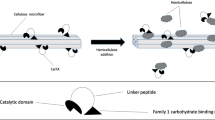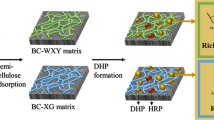Abstract
Cellulose composites were produced by culturing Acetobacter aceti subsp. xylinum (ATCC 53524, agitation tolerant strain) under shaking and agitating conditions in the presence of 2% pine or beech Björkman lignin-carbohydrate complexes (LCCs) or six different types of hemicellulosic polysaccharides including glucuronoxylan, glucomannan, O-acetyl-glucuronoxylan, arabinoglucuronoxylan, arabinogalactan and xyloglucan. Hemicellulosic polysaccharide contents in cellulose composites were similar in spite of the differences in culture, shaking and agitating conditions. On the basis of hemicellulosic polysaccharide contents and X-ray diffraction patterns after extraction by dilute NaOH solution, glucomannan family polysaccharides were found to have the highest affinity to bacterial cellulose. Composites with neutral and acidic LCCs were resistant against alkali while high lability of their delignified carbohydrates against alkali indicates the importance of lignin for formation of cellulose-hemicellulose-lignin framework of plant secondary cell-walls.
Similar content being viewed by others
REFERENCES
Adams, G. A. (1965) Arabinoglycuronoxylan, arabinoxylan, and xylan; Purification using a copper complex and purification by fractional precipitation of acetates. In Methods in Carbohydrate Chemistry Vol. V: Polysaccharides Preparations (R. L. Whistler, ed.). Academic Press, New York, pp. 170-;175.
Atalla, R. H. and VanderHart, D. L. (1984) Native cellulose: A composite of two distinct crystalline forms. Science 223, 283-;285.
Atalla, R. H., Hackney, J. M., Uhlin, I. and Thompson, N. S. (1993) Hemicelluloses as structure regulators in the aggregation of native cellulose. Int. J. Biol. Macromol. 15, 109-;112.
Azuma, J. (1989) Analysis of lignin-carbohydrate complexes of plant cell walls. In Plant fibers edited by H. F. Linskens and J. F. Jackson. Springer-Verlag, Berlin, pp. 100-;126.
Ben-Hayim, G. and Ohad, I. (1965) Synthesis of cellulose by Acetobacter xylinum. VIII. On the formation and orientation of bacterial cellulose fibrils in the presence of acidic polysaccharides. J. Cell Biol. 25, 191-;207.
Brown, R. M., Jr., Haigler, C. and Cooper, K. (1982) Experimental induction of altered nonmicrofibrillar cellulose. Science 218, 1141-;1142.
Dubois, M., Gilles, K. A., Hamilton, J. K., Rebers, P. A. and Smith, F. (1956) Colorimetric method for determination of sugars and related substances. Anal. Chem. 28, 350-;356.
Gidley, M. J., Lillford, P. J., Rowlands, D. W., Lang, P., Dentini, M., Crescenzi, V., Edwards, M., Fanutti, C. and Grant Reid, J. S. (1991) Structure and solution properties of tamarind-seed polysaccharide. Carbohydr. Res. 214, 299-;314.
Hackney, J. M., Atalla, R. H. and VanderHart, D. L. (1994) Modification of crystallinity and crystalline structure of Acetobacter xylinum cellulose in the presence of water-soluble β-1,4-linked polysaccharides: 13C-NMR evidence. Int. J. Biol. Macromol. 16, 215-;218.
Haigler, C. H., Brown, R. M., Jr. and Benziman, M. (1980) Calcofluor White ST alters the in vivo assembly of cellulose microfibrils. Science 210, 903-;906.
Haigler, C. H., White, A. R., Brown, R. M., Jr. and Cooper, K. M. (1982) Alteration of in vivo cellulose ribbon assembly by carboxymethylcellulose and other cellulose derivatives. J. Cell Biol. 94, 64-;69.
Hestrin, S. and Schramm, M. (1954) Synthesis of cellulose by Acetobacter xylinum. Biochem. J. 58, 345-;352.
Huang, Y., Indrarti, L., Azuma, J. and Okamura, K. (1992) Simultaneous determination of xylose and uronic acid in beech xylan by methanolysis. Mokuzai Gakkaishi 38, 1168-;1171.
Kai, A. and Xu, P. (1991) Orientation of crystallites in the bacterial cellulose-fluorescent brightener complex membrane. Koubunshi Ronbunshu 48, 449-;452.
Kai, A. and Mondal, I. H. (1997) Influence of substituent of direct dye having bisphenylenebis(azo) skeletal structure on structure of nascent cellulose produced by Acetobacter xylinum [I]: different influence of Direct Red 28, Blue 1 and 15 on nascent structure. Int. J. Biol. Macromol. 20, 221-;231.
Karácsonyi, S., Alföldi, J., Kubacková, M. and Stupka, L. (1983) Chemical and 13C-NMR studies on the distribution of the O-acetyl groups in O-acetyl (4-O-methyl-D-glucurono)-D-xylan from white willow (Salix alba L.). Cellulose Chem. Technol. 17, 637-;645.
Karácsonyi, S., Kovácik, V., Alföldi, J. and Kubacková, M. (1984) Chemical and 13C-N.M.R. studies of an arabinogalactan from Larix sibirica L. Carbohydr. Res. 134, 265-;274.
Laffend, K. B. and Swenson, H. A. (1968) Effect of acetyl content of glucomannan on its sorption onto cellulose and its beater additive properties II. Effect on beater additive properties. Tappi 51, 141-;143.
Saeman, J. F., Moore, W. E., Mitchell, R. L. and Millett, M. A. (1954) Technique for the determination of pulp constituents by quantitative paper chromatography. Tappi 37, 336-;343.
Sugiyama, J., Okano, T., Yamamoto, H., Horii, F. (1990) Transformation of Valonia cellulose crystals by an alkaline hydrothermal treatment. Macromolecules 23, 3196-;3198.
Sugiyama, J., Persson, J. and Chanzy, H. (1991a) Combined infrared and electron diffraction study of the polymorphism of native celluloses. Macromolecules 24, 2461-;2466.
Sugiyama, J., Vuong, R. and Chanzy, H. (1991b) Electron diffraction study on the two crystalline phases occurring in native cellulose from an algal cell wall. Macromolecules 24, 4168-;4175.
Timell, T. E. (1965) Glucomannans from the wood of angiosperms. In Methods in Carbohydrate Chemistry Vol. V: Polysaccharides Preparations (R. L. Whistler, ed.). Academic Press, New York, pp. 137-;138.
Uhlin, K. I., Atalla, R. H. and Thompson, N. S. (1995) Influence of hemicelluloses on the aggregation patterns of bacterial cellulose. Cellulose 2, 129-;144.
VanderHart, D. L. and Atalla, R. H. (1984) Studies of microstructure in native celluloses using solid-state 13C NMR. Macromolecules 17, 1465-;1472.
Yamamoto, H. and Horii, F. (1994) In situ crystallization of bacterial cellulose I. Influences of polymeric additives, stirring and on the formation of cellulose Iα and Iβ as revealed by cross polarization/;magic angle spinning (CP/;MAS) 13C NMR spectroscopy. Cellulose 1, 57-;66.
Yamamoto, H., Horii, F. and Hirai, A. (1996) In situ crystallization of bacterial cellulose II. Influences of different polymeric additives on the formation of cellulose Iα and Iβ at the early stage of incubation. Cellulose 3, 229-;242.
Author information
Authors and Affiliations
Rights and permissions
About this article
Cite this article
Iwata, T., Indrarti, L. & Azuma, JI. Affinity of Hemicellulose for Cellulose Produced by Acetobacter Xylinum. Cellulose 5, 215–228 (1998). https://doi.org/10.1023/A:1009237401548
Issue Date:
DOI: https://doi.org/10.1023/A:1009237401548




